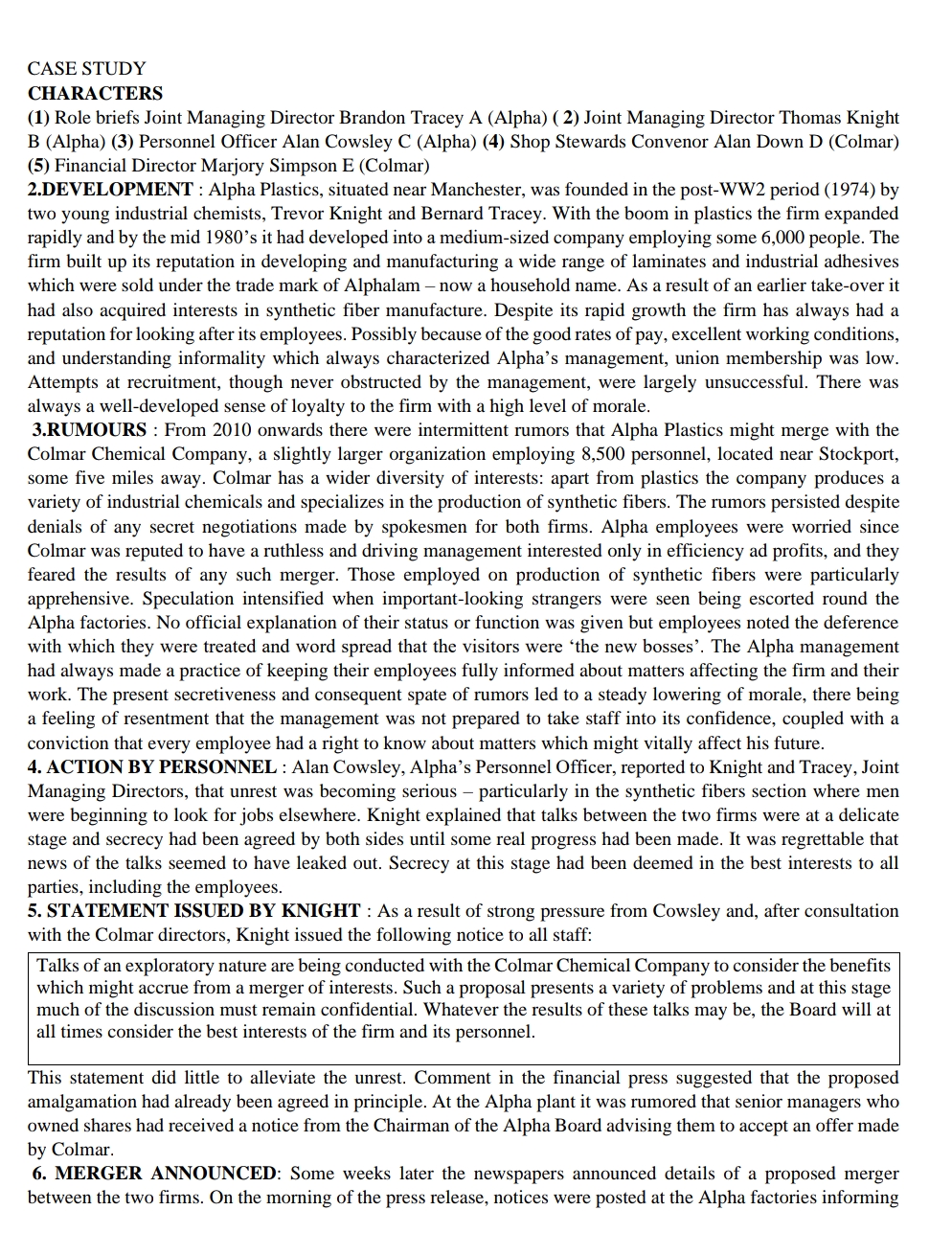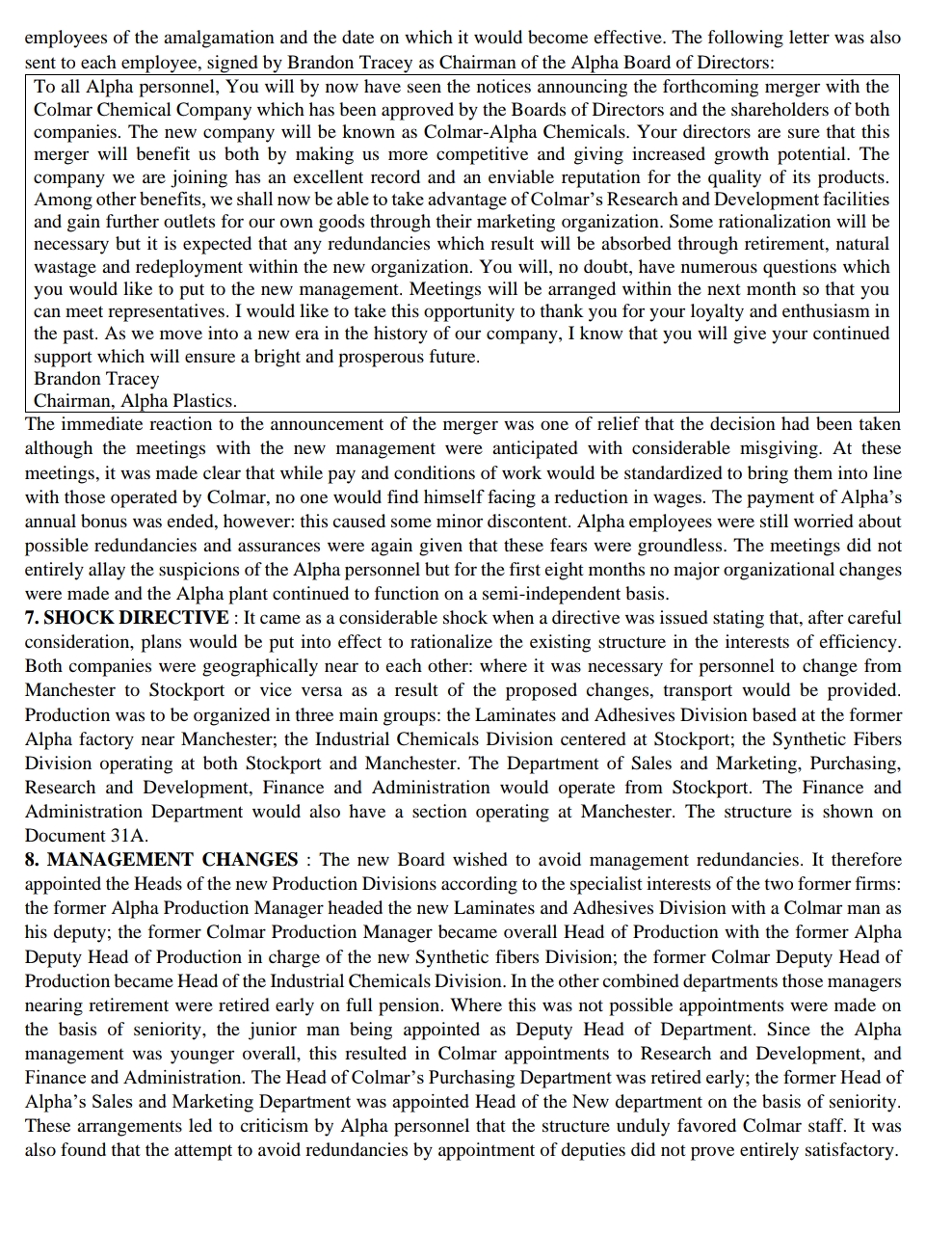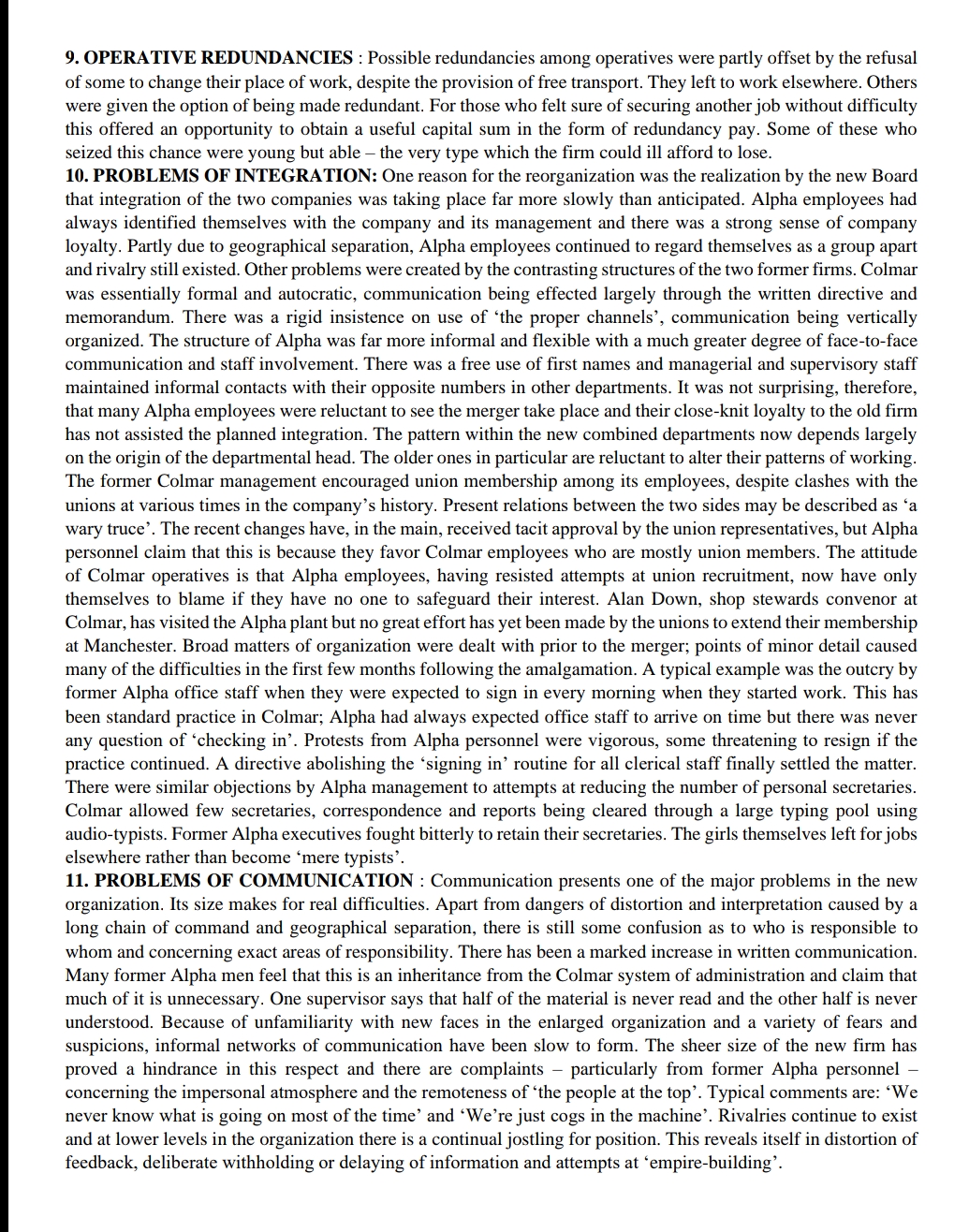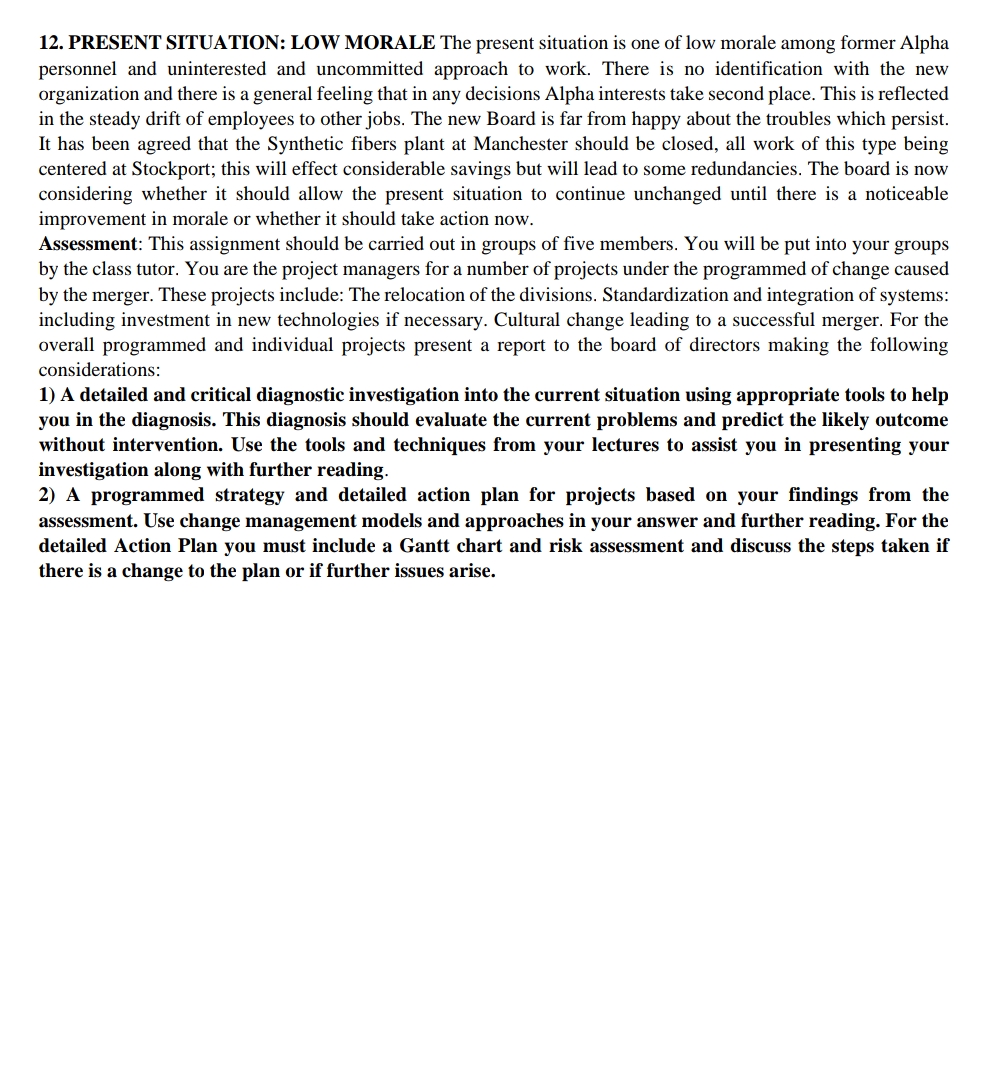CASE STUDY CHARACTERS (1} Role briefs Joint Managing Director Brandon Tracey A (Alpha) (2} Joint Managing Director Thomas Knight B (Alpha) (3) Personnel Ofcer Alan Cowsley C (Alpha) (4) Shop Stewards Convenor Alan Down D (Colmar) (5} Financial Director Marjory Simpson E (Colmar) 2.DEVELOPMENT : Alpha Plastics, situated near Manchester, was founded in the post~WW2 period (1914) by two young industrial chemists, Trevor Knight and Bernard Tracey. With the boom in plastics the fum expanded rapidly and by the mid 1930's it had developed into a mediumusized company employing some 6,000 people. The rm built up its reputation in developing and manufacturing a wide range of laminates and industrial adhesives which were sold under the trade mark of Alphalam now a household name. As a result of an earlier take-over it had also acquired interests in synthetic ber manufacture. Despite its rapid growth the rm has always had a reputation for looking after its employees. Possibly because of the good rates of pay, excellent working conditions, and understanding informality which always characterized Alpha's management, union membership was low. Attempts at recruitment, though never obstructed by the management, were largely unsuccessful. There was always a welladeveloped sense of loyalty to the rm with a high level of morale. 3.RUMOURS : From 2010 onwards there were intermittent mmors that Alpha Plastics might merge with the Colmar Chemical Company, a slightly larger organization employing 8,500 personnel, located near Stockport, some ve miles away. Colmar has a wider diversity of interests: apart from plastics the company produces a variety of industrial chemicals and specializes in the production of synthetic bers. The rumors persisted despite denials of any secret negotiations made by spokesmen for both fums. Alpha employees were worried since Colmar was reputed to have a ruthless and driving management interested only in efciency ad prots, and they feared the results of any such merger. Those employed on production of synthetic bers were particularly apprehensive. SpeCulation intensied when importanthlooking strangers were seen being escorted round the Alpha factories. No ofcial explanation of their status or function was given but employees noted the deference with which they were treated and word spread that the visitors were 'the new bosses'. The Alpha management had always made a practice of keeping their employees fully informed about matters affecting the rm and their work. The present secretiveness and consequent spate of rumors led to a steady lowering of morale, there being a feeling of resentment that the management was not prepared to take staff into its condence, coupled with a conviction that every employee had a right to know about matters which might vitally affect his future. 4. ACTION BY PERSONNEL : Alan COWSley, Alpha's Personnel Officer, reported to Knight and Tracey, Joint Managing Directors, that unrest was becoming serious particularly in the synthetic fibers section where men were beginning to look for jobs elsewhere. Knight explained that talks between the two furns were at a delicate stage and secrecy had been agreed by both sides until some real progress had been made. It was regrettable that news of the talks seemed to have leaked out. SecreCy at this stage had been deemed in the best interests to all parties, including the employees. 5. STATEMENT ISSUED BY KNIGHT : As a result of strong pressure from Cowsley and, after consultation with the Colmar directors, Knight issued the following notice to all staff: Talks of an exploratory nature are being conducted with the Colmar Chemical Company to consider the benets which might accrue from a merger of interests. Such a proposal presents a variety of problems and at this stage much of the discussion must remain condential. Whatever the results of these talks may be, the Board will at all times consider the best interests of the rm and its personnel. This statement did little to alleviate the unrest. Comment in the nancial press suggested that the proposed amalgamation had already been agreed in principle. At the Alpha plant it was rumored that senior managers who owned shares had received a notice from the Chairman of the Alpha Board advising them to accept an offer made by Colrnar. 6. MERGER ANNOUNCED: Some weeks later the newspapers armounced details of a proposed merger between the two rms. On the morning of the press release, notices were posted at the Alpha factories informing employees of the amalgamation and the date on which it would become effective. The following letter was also sent to each employee, signed by Brandon Tracey as Chairman of the Alpha Board of Directors: To all Alpha personnel, You will by now have seen the notices announcing the forthcoming merger with the Colmar Chemical Company which has been approved by the Boards of Directors and the shareholders of both companies. The new company will be known as Colmar-Alpha Chemicals. Your directors are sure that this merger will benefit us both by making us more competitive and giving increased growth potential. The company we are joining has an excellent record and an enviable reputation for the quality of its products. Among other benets, we shall now be able to take advantage of lColmar's Research and Development facilities and gain further outlets for our own goods through their marketing organization. Some rationalization will be necessary but it is expected that any redundancies which result will be absorbed through retirement, natural wastage and redeployment within the new organization. You will, no doubt, have numerous questions which you would like to put to the new management. Meetings will be arranged within the next month so that you can meet representatives. I would like to take this opportunity to thank you for your loyalty and enthusiasm in the past. As we move into a new era in the history of our company, I know that you will give your continued support which will ensure a bright and prosperous future. Brandon Tracey Chairman, Alpha Plastics. The immediate reaction to the announcement of the merger was one of relief that the decision had been taken although the meetings with the new management were anticipated with considerable misgiving. At these meetings, it was made clear that while pay and conditions of work would be standardized to bring them into line with those operated by Colmar, no one would nd himself facing a reduction in wages. The payment of Alpha's annual bonus was ended, however: this caused some minor discontent. Alpha employees were still worried about possible redundancies and assurances were again given that these fears were groundless. The meetings did not entirely allay the suspicions of the Alpha personnel but for the rst eight months no major organizational changes were made and the Alpha plant continued to function on a semi-independent basis. 7. SHOCK DIRECTIVE: It came as a considerable shock when a directive was issued stating that, after careful consideration, plans would be put into effect to rationalize the existing structure in the interests of efciency. Both companies were geographically near to each other: where it was necessary for personnel to change from Manchester to Stockport or vice versa as a result of the proposed changes, transport would be provided. Production was to be organized in three main groups: the Laminates and Adhesives Division based at the former Alpha factory near Manchester; the Industrial Chemicals Division centered at Stockport; the Synthetic Fibers Division operating at both Stockport and Manchester. The Department of Sales and Marketing, Purchasing, Research and Development, Finance and Administration would operate from Stockport. The Finance and Administration Department would also have a section operating at Manchester. The structure is shown on Document 31A. 8. MANAGEMENT CHANGES : The new Board wished to avoid management redundancies. It therefore appointed the Heads of the new Production Divisions according to the specialist interests of the two former rms: the former Alpha Pmduction Manager headed the new Laminates and Adhesives Division with a Colmar man as his deputy; the former Colmar Production Manager became overall Head of Production with the former Alpha Deputy Head of Production in charge of the new Synthetic bers Division; the former Colmar Deputy Head of Production became Head of the Industrial Chemicals Division. In the other combined departments those managers nearing retirement were retired early on full pension. Where this was not possible appointments were made on the basis of seniority, the junior man being appointed as Deputy Head of Department. Since the Alpha management was younger overall, this resulted in Colmar appointments to Research and Development, and Finance and Administration. The Head of Cohnar's Purchasing Department was retired early; the former Head of Alpha's Sales and Marketing Department was appointed Head of the New department on the basis of seniority. These arrangements led to criticism by Alpha personnel that the structure unduly favored Colmar staff. It was also found that the attempt to avoid redundancies by appointment of deputies did not prove entirely satisfactory. 9. OPERATIVE REDUNDANCIES : Possible redundancies among operatives were partly offset by the refusal of some to change their place of work, despite the provision of free transport. They left to work elsewhere. Others were given the option of being made redundant. For those who felt sure of securing another job without difculty this offered an opportunity to obtain a useful capital sum in the form of redundancy pay. Some of these who seized this chance were young but able the very type which the rm could ill afford to lose. 10. PROBLEMS OF INTEGRATION: One reason for the reorganization was the realization by the new Board that integration of the two companies was taking place far more slowly than anticipated. Alpha employees had always identied themselves with the company and its management and there was a strong sense of company loyalty. Partly due to geographical separation, Alpha employees continued to regard themselves as a group apart and rivalry still existed. Other problems were created by the contrasting structures of the two former rms. Colmar was essentially formal and autocratic, communication being effected largely through the written directive and memorandum. There was a rigid insistence on use of 'the proper charmels', communication being vertically organized. The structure of Alpha was far more informal and exible with a much greater degree of faceutoface communication and staff involvement. There was a free use of rst names and managerial and supervisory staff maintained informal contacts with their opposite numbers in other departments. It was not surprising, therefore, that many Alpha employees were reluctant to see the merger take place and their close-knit loyalty to the old rm has not assisted the planned integration. The pattern within the new combined departments now depends largely on the origin of the departmental head. The older ones in particular are reluctant to alter their patterns of working. The former Colrnar management encouraged union membership among its employees, despite clashes with the unions at various times in the company's history. Present relations between the two sides may be described as 'a wary truce'. The recent changes have, in the main, received tacit approval by the union representatives, but Alpha personnel claim that this is because they favor Colmar employees who are mostly union members. The attitude of Colrnar operatives is that Alpha employees, having resisted attempts at union recruitment, now have only themselves to blame if they have no one to safeguard their interest. Alan Down, shop stewards convenor at Colrnar, has visited the Alpha plant but no great effort has yet been made by the unions to extend their membership at Manchester. Broad matters of organization were dealt with prior to the merger; points of minor detail caused many of the difculties in the rst few months following the amalgamation. A typical example was the outcry by former Alpha ofce staff when they were expected to sign in every morning when they started work. This has been standard practice in Colrnar; Alpha had always expected ofce staff to arrive on time but there was never any question of 'checking in'. Protests from Alpha personnel were vigorous, some threatening to resign if the practice continued. A directive abolishing the 'signing in' routine for all clerical staff nally settled the matter. There were similar objections by Alpha management to attempts at reducing the number of personal secretaries. Colrnar allowed few secretaries, correspondence and reports being cleared through a large typing pool using audiotypists. Former Alpha executives fought bitterly to retain their secretaries. The girls themselves left for jobs elsewhere rather than become 'mere typists'. ll. PROBLEMS OF COMMUNICATION : Communication presents one of the major problems in the new organization. Its size makes for real difculties. Apart from dangers of distortion and interpretation caused by a long chain of command and geographical separation, there is still some confusion as to who is responsible to whom and concerning exact areas of responsibility. There has been a marked increase in written communication. Many former Alpha men feel that this is an inheritance from the Colrnar system of administration and claim that much of it is unnecessary. One supervisor says that half of the material is never read and the other half is never understood. Because of unfamiliarity with new faces in the enlarged organization and a variety of fears and suspicions, informal networks of communication have been slow to form. The sheer size of the new fmn has proved a hindrance in this respect and there are complaints particularly from former Alpha personnel concerning the impersonal atmosphere and the remoteness of 'the people at the top'. Typical comments are: 'We never know what is going on most of the time' and 'We're just cogs in the machine'. Rivalries continue to exist and at lower levels in the organization there is a continual jostling for position. This reveals itself in distortion of feedback, deliberate withholding or delaying of information and attempts at 'empirebuilding'. 12. PRESENT SITUATION: LOW MORALE The present situation is one of low morale among former Alpha personnel and uninterested and uncommitted approach to work. There is no identication with the new organization and there is a general feeling that in any decisions Alpha interests take second place. This is reected in the steady drift of employees to other jobs. The new Board is far from happy about the troubles which persist. It has been agreed that the Synthetic bers plant at Manchester should be closed, all work of this type being centered at Stockport; this will effect considerable savings but will lead to some redundancies. The board is now considering whether it should allow the present situation to continue unchanged until there is a noticeable improvement in morale or whether it should take action now. Assessment: This assignment should be carried out in groups of five members. You will be put into your groups by the class tutor. You are the project managers for a number of projects under the programmed of change caused by the merger. These projects include: The relocation of the divisions. Standardization and integration of systems: including investment in new technologies if necessary. Cultural change leading to a successful merger. For the overall programmed and individual projects present a report to the board of directors making the following considerations: 1) A detailed and critical diagnostic investigation into the current situation using appropriate tools to help you in the diagnosis. This diagnosis should evaluate the current problems and predict the liker outcome without intervention. Use the tools and techniques from your lectures to assist you in presenting your investigation along with further reading. 2) A programmed strategy and detailed action plan for projects based on your findings from the assessment. Use change management models and approaches in your answer and further reading. For the detailed Action Plan you must include a Gantt chart and risk assessment and discuss the steps taken if there is a change to the plan or if further issues arise










